Sunday, August 31, 2003
CULTURE-HOPPING
There's an excellent article by Charles Glass about Syrian politics and people's daily realities on the online archive of The London Review of Books.
Dr. Dean and Cherry Garcia: a city reporter tries to understand "Vermont Style" -- this story in yesterday's New York Times was very amusing to me, and probably confusing to others. Don't miss the accompanying multimedia slide show. (Thanks, E.)

America Ferrara in Real Women Have Curves
Last night we saw a terrific movie: Real Women Have Curves, about the youngest daughter in a family of Mexican immigrants living in present-day L.A. Great performances, especially by the young lead actress, and a wonderful screenplay. For the past couple of nights I had been reading the current issue of Harvard Divinity Bulletin, in which there was a stereotype-exploding article, "Rethinking the Melting Pot", by Daisy Machado, about so-called "Latino" culture in America. The author quoted a poem by Pat Mora, and it reminded me of the women in the movie:
Desert Women
Desert women know
about survival.
Fierce heat and cold
have burned and thickened
our skin.
Like cactus
we've learned to hoard,
to sprout deep roots,
to seem asleep, yet wake
at the scent of softness
in the air,
to hide
pain and loss by silence,
no branches wail
or whisper our sad songs
safe behind our thorns.
Don't be deceived.
When we bloom, we stun.
From the same excellent issue of HDB, I'd also like to recommend Reflections on Islam in a Time of Global Uncertainty by William A. Graham, an article on Emerson's spirituality by Richard Higgins, and Religion and the Creation of Feminist Consciousness by Gerda Lerner. All are available online, in case you needed something else to read this weekend!
7:17 PM
|
Friday, August 29, 2003
I'd like to commend to you, in addition to the comments on "Primitive" and "Naive" Art here, recent posts on the subject at The Coffee Sutras and Pretty Serendipities.
Soon I'm going to take on the definitions that keep cropping up: "primitive", "naive", "folk"; like E. I find them limiting both to the artists themselves, and to us by interposing language and a suggested meaning before we ever look at the work.
For today, I wanted to think instead about what makes us respond to a work of art, regardless of its genre, acceptability under various criteria, period, or technique. The famous art teacher Robert Henri had something rather profound to say about this (with apologies from me for his sexist language - it was 1923!):
An art student must be a master from the beginning; that is, he must be master of such as he has. By being now master of such as he has there is promise that he will be master in the future.
A work of art which inspires us comes from no quibbling or uncertain man. It is the manifest of a very positive nature in great enjoyment, and at the very moment the work was done.
It is not enough to have thought great things before doing the work. The brush stroke at the moment of contact carries inevitably the exact state of being of the artist at that exact moment into the work, and there it is, to be seen and read by those who can read such signs, and to be read later by the artist himself, with perhaps some surprise, as a revelation of himself.
For an artist to be interesting to us he must have been interesting to himself. He must have been capable of intense feeling, and capable of profound contemplation.
He who has contemplated has met with himself, is in a state to see into the realities beyond the surface of his subject. nature reveals to him, and, seeing and feeling intensely, he paints, and whether he wills it or not each brush stroke is an exact record of such as he was at the exact moment the stroke was made.
Robert Henri, The Art Spirit, 1923
8:19 PM
|
Thursday, August 28, 2003
Mars was spectacular last night. We went out around 9 pm to put a DVD back in the mail, and J. drove around to some of the best sky-viewing points so we could look at the red planet, presiding over a night sky ablaze with stars. Apparently you can see the polar ice caps if you have access to a telescope.
Right now I'm anxious to hear from some of my UK readers about their power outage - strange business, coming so soon after the one here. I'm suspicious. I hope none of you had frightening experiences, caught in the tube.
I went to the market and bought a bunch of meat and fish which I froze in small portions, and now I'm on a cooking binge this late afternoon, trying to make some food to keep for busy days ahead. So far I've cooked the eggplant for an Iranian eggplant kuku, a sort of marriage of a souffle and frittata, and have been soaking some jasmine rice in salted water for the past four hours, for tadik (Iranian rice-with-a-crust). A cucumber salad made from cucumbers fresh from thegarden, yogurt,and fresh mint will complete our meal tonight, but there will be plenty of rice and eggplant left over, and if the weather stays fairly cool I'll make a chicken stew tomorrow. We got word that Shirin landed safely in Iran and didn't have problems entering the country; maybe I'm cooking for her.
Tonight is our first choir practice of the new season, and we'll begin work on the Mozart Requiem, which I've never sung, for All Saint's Day, as well as music that we'll be singing at Gene Robinson's consecration in November. I'm ready to getback to singing. But right now it's teatime, and I'm sitting in the north side of our upstairs living room/library, a small cozy area where there are two windows at right angles looking out on some big maple trees and the garden. Yesterday there was a breeze, and I laid back on the couch with my tea, just watching the tree branches toss in the wind and feeling it on my skin - that late summer feeling of warmth and relaxation mixed with melancholy. Today the light is bright, the trees still, and the neighborhood noisier with crickets, children's voices and traffic; nature is staying outside, resiliantly summery. And so it will go for the next few weeks, see-sawing between seasons and emotions.
4:06 PM
|
Wednesday, August 27, 2003
MARS-DAY
It’s a clear day here, so I’m hoping to be able to see Mars tonight as the two planets pass as close together as they’ve been in 60,000 years. It is definitely Mars-day, even if it is Wednesday, not Tuesday!
Mars, the Roman god of war, lent his name to so much in modern parlance that the connection barely registers. Not only do we have the month of March, and the French their Mardi (Tuesday), but our English word Tuesday actually comes from the same root. The Old English twesdaeg and similar words in Old High German and Old Norse all come from a prehistoric West Germanic-North Germanic compound formed from the Old English Tiw, god of war, and daeg day; this is a translation of Latin Martis dies, literally, day of Mars (Roman god of war), which in turn is a translation of the Greek hemera Areios, literally, day of Ares (Greek god of war). (Merriam-Webster).
I also discovered that mars is a now-obsolete alchemical word for iron, which I suspect came more from red color of iron-containing rocks rather than the connection to iron weapons – but that’s just a guess.
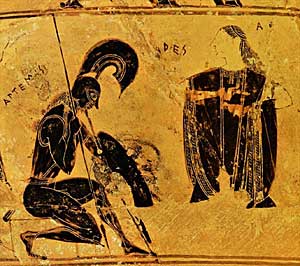
Ares Kneeling Before Aphrodite (The Francois Vase)
Old classicist that I am, I went on a little art-and-myth foray this morning and turned up several depictions of Mars. The God of War is rarely depicted alone; what appealed to both classical and romantic artists was the illicit courtship of Mars/Ares and Venus/Aphrodite, who was married to Vulcan/Hephaistos, the lame smith who was a son of Juno/Hera, wife of Jupiter/Zeus.
My favorite (because I especially love early Greek art), above, shows Ares Kneeling Before Aphrodite on an Attic black figure volute krater known as the Francois Vase. If you look closely you can see "ARES" in Greek letters to the right of the kneeling figure; Aphrodite is standing and "ARTEMIS" must be beyond her name, to the left.
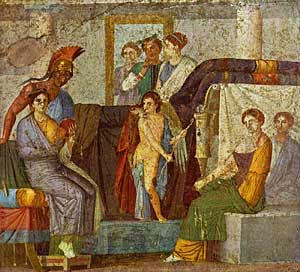
Another beautiful painting of the Courtship of Mars and Venus comes from the House of Marcus Lucretius Fronto, Pompeii
And a painting by Martin van Heemskerk (1536) intrigued me, not for its florid style but because I had forgotten the story of Mars and Venus Caught in the Net. Homer relates the tale in Book 8 of the Odyssey; the central portion is below, and you can read the whole story here. (The online version is a translation by Butler. Below is Lattimore, which I prefer greatly; it's much closer to the original in feeling.)
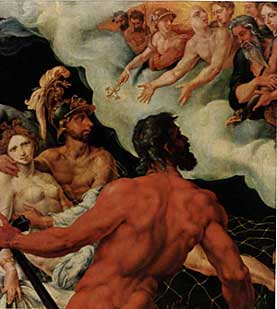
Demodokos struck the lyre and began singing well the story about thelove of Ares and sweet-garlanded Aphrodite, how they first lay together in the house of Hephaistos secretly; he gave her much and fouled the marriage and bed of the lord Hephaistos; to him there came as messenger Helios, the sun, who had seen them lying in love together. Hephaistos, when he had heard the heartsore story of it, went on his way to his smithy, heart turbulent with hard sorrows, and set the great anvil upon its stand, and hammered out fastenings that could not be slipped or broken, to hold them fixed in position...he went to his chamber where his own dear bed lay, and spun his fastenings around the posts form every direction, while many more were suspended overhead, from the roof beams, thin, like spider webs, which not even one of the blessed gods could see. He had fashioned it to be very deceptive...
So...these two went to bed, and slept there, and all about them were bending the artful bonds that had been forged by subtle Hephaistos, so neither of them could stir a limb or get up, and now they saw the truth, and there was no longer a way out for them...
Odyssey, Book 8, 266-281 and 295-299 (Lattimore)
Ares and Aphrodite eventually got out of their trap, though, and escaped unpunished - gods are gods, after all - and we inherited Mars and Venus as our closest planetary neighbors and eternal archetypes of "man" and "woman".
A few more images are below.
Ares in battle, behind the fallen Kyknos on an Attic Black Figure neck-amphora (c 515-500 BC):. Worcester Art Museum 1966.63 (This is very nice.)
Ares and Aphrodite
Mars and Venus United by Love, Paolo Veronese (Paolo Caliari) (Italian, Venetian, 1528–1588), Metropolitan Museum of Art, New York
2:27 PM
|
Tuesday, August 26, 2003
AN AMERICAN PRIMITIVE
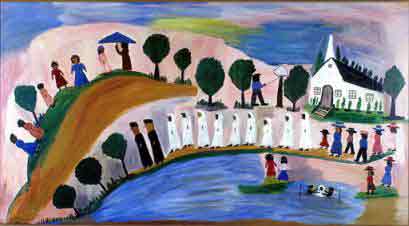
Clementine Hunter, Panorama of Baptism on Cane River, 1945, oil painting on a window shade
As usual, I got sidetracked. My plan for today was to write a post about Picasso’s relationship to primitive art, but then I found and feasted upon the gorgeous banquet of summer berry paintings at Pretty Serendipities. That got me thinking about American folk painting, and off I went searching for some berries in that genre. Instead, I found the work of Clementine Hunter.
Here’s a brief bio of the artist, liberally swiped from the new Odgen Museum of Southern Art in New Orleans (the museum opened on Sunday, August 23rd).
Clementine Hunter was born Clemence Reuben in 1886 or 1887 on Hidden Hill cotton plantation, Louisiana (A notorious place which supposedly inspirated Harriet Beecher Stowe's Uncle Tom's Cabin.) Her family eventually moved to Melrose Plantation, where the little girl’s name changed to Clementine. She worked in the fields and later was in the house as a servant, cook, and caretaker of children.
“In 1940, the New Orleans artist Alberta Kinsey visited Melrose to paint magnolias. She used an old kitchen as a studio. After her departure it was Clementine's task to tidy up the building. She found several tubes of paint Miss Kinsey had left behind. That evening, she approached Mignon, saying she could "mark" a picture of her own. He gave her an old window shade, some brushes and turpentine. The next morning, she delivered to him a picture. In the years following, she painted whenever she had time, on anything she could find - from cardboard boxes, brown paper bags, lumber, to plastic milk cartons and wine bottles.”
Gradually, visitors to the plantation began to notice Clementine Hunter’s work, and helped her by procuring supplies and support. She had her first show in 1955, in New Orleans, and also at Northwestern State College in Natchitoches. She wasn’t allowed to see her work in the gallery when white patrons were there, but only on a Sunday when the gallery was closed.

“Clementine Hunter referred to her works as memory paintings, because they depict scenes of everyday life around the plantation and her church. ..Clementine lived at Melrose until 1978, when she moved to her trailer house several miles away. She continued to work through her hundredth year. In her long career she created several thousand paintings, which sold from twenty-five cents in the early days to several thousand dollars in the 1980s. In addition to paintings, she created quilts and dolls. She became one of the most important African American artists in history, as her life literally encompassed the major changes of the 20th century - segregation, world wars, economic depression, the Civil Rights movement, and more. She died January 1, 1988, having never been over 100 miles from her home.”
So, in light of our ongoing discussion, I’m curious what readers think of this type of “folk” art. In America we have a long tradition of naïve paintings – portraits, still lives, and scenes from daily life -- beginning in the early American period and re-popularized in our time by Grandma Moses (who detested the term “primitive”). Do you like it? Do you feel it’s art? If so, is it “good” art?
And tomorrow, on to Picasso, who we can also argue about! Meanwhile, please go look at those berry paintings. Elena has put together something quite wonderful.
3:53 PM
|
Monday, August 25, 2003
ATELIER CEZANNE
via Ikastikos
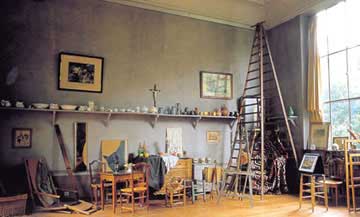
Happy Monday. Maybe you'd like to take a little break from your day, as I did, and visit Cezanne's studio in Aix en Provence. Lovely pictures of the actual place and some of the artist's familiar paintings and objects. I have a poster on my studio wall, a view of Mt. St. Victoire. from the unforgettable Cezanne exhibition at MOMA in late 1977. I think that was the first "blockbuster" exhibition I ever attended, and it was packed - but the hoards didn't interfere with the intensite visual and emotional experience of walking into a huge room filled with Cezanne still lives.

Be sure to view the panoramic tour of the studio as well as the still photos.
1:03 PM
|
Sunday, August 24, 2003
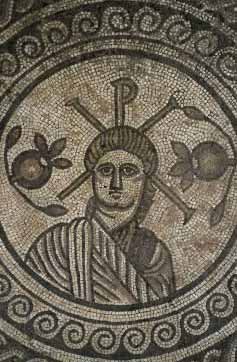
The Hinton St. Mary mosaic, Britain, 4th C AD, which may be one of the earliest depictions of Christ. It includes the chi-rho symbol (the first two letters, in Greek, of "Christos") and two pomegranates, which were ancient pagan symbols of immortality - later replaced in similar combinations with the chi-rho by an alpha and omega, for "beginning and end". From the Roman Britain galleries at the British Museum.
A few months ago, a friend told me about a summer solstice party she had this year, attended by some seventy women of various ages. They all walked a labyrinth she had made on her property, and as the sun went down, formed a big circle, held hands and chanted - I'm not sure what. "The energy was incredible," she said, "You have to come next time."
I'm sure the energy was amazing, but I don't think I'll be going. It's odd, how in my daily life I can question my commitment to Christianity and find all sorts of bones to pick with the dogma and the Church, but when I'm actually faced with participating in what to me is a pagan celebration, something in me balks, and I can't quite do it. I'm surprised when that happens, because I quite willingly participate in Jewish and Muslim worship, and as you all know by now, have no problem accomodating Zen into my spiritual life.
Paganism, though, is something else, and whether present-day solstice celebrations are overtly pagan or not, something in me says, "uh-uh, not for me." Of course, I recognize (and have written here) that many of our Christian holidays are pagan in origin, "rolled over", as it were, to help accomodate local beliefs in a converting population - which England, for example, was at one time. The pagans were out there worshipping the sun and all manner of gods, and their symbols appear cheek-by-jowl with the chi-rho, the fish, and other early Christian symbols on everything from mosaic floors to the most elaborate silver dinner platters of the 3rd century on.
Having said all that, today after church I was working in my garden. It's the first cool day in ages, but a glorious one with a clear sky. The sun was beating on my back as I worked, and raising the scent of hot ferns, warm earth, and crushed lavender leaves. Oh, it's so elemental there in the garden. Earth, water, air, and fire. Sustaining plants, hungry mammal. On my knees in the garden, tugging at roots, remembering the bare ground in spring amid this near-autumn chaotic splendor, I could well understand why people fell down and worshipped the sun and made gods of the other elements. Our bodies are, after all, made of the same things, and, nose-to-nose with life-giving earth, we know it. But ---there's more.
5:14 PM
|
Saturday, August 23, 2003
"Writing is ninety percent listening. You listen so deeply to the space around you that it fills you - and you write and it pours out of you. The deeper you can listen, the better you can write."
- John Welwood via whiskey river
7:14 PM
|
Friday, August 22, 2003
WHAT IS ART, AND WHEN DID IT BEGIN?
"We have discovered nothing new in art in 17,000 years."
Pablo Picasso, on visiting Lascaux
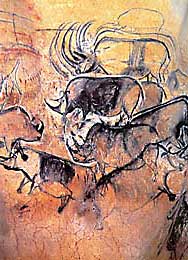
Painted panel from the Grotte Chauvet; more than 30,000 years old.
Sometimes I get a reflexive reaction of wanting to reach out and slam the nearest art historian. The thrust of today's Japan Times article on prehistoric art seemed to be, "If the making of art is one definition of what makes us human, then which of these early efforts can actually be called art?"
I guess my definition of what makes art "art" is awfully broad: art is self-expression. That definition refuses to look at art through a Eurocentric filter, and it refuses to dismiss the "primitive" efforts of non-literate societies, or children, or elderly, or disabled people, as non-art. I sometimes wonder how many art historians and art critics have actually ever MADE a piece of art; if they had I don't think they'd be so high-minded. Don't get me wrong; there are some very astute people writing about art out there. But this particular bias has always really irked me because it is designed to exclude.
As for myself, I'm knocked out (and inspired) by prehistoric art, and cave painting in particular. I haven't been to any of the famous caves, but I know if and when I am able to go, it will be an overpowering experience of immediacy and connection.
Despite my rant, these two articles are worth reading:
Taking shape: Prehistoric art and us from The Japan Times.
In the 19th century, scientists finally junked the Biblical idea of a seven-day divine Creation -- with man, at the pinnacle of the process, being fashioned from clay on the sixth day...Ever since, it seems, we haven't stopped searching for our secular version of the "sixth day": the dawn of modern humans...
Aboriginal Art in Australia (New York Times)
In a cave in rugged wilderness not far from the luxurious country resorts of this city's well-to-do, a leading anthropologist has found an unusually rare and pristine cache of ancient Aboriginal rock art...In all, 11 layers of images of Australian animals — kangaroos, wombats and monitor lizards, which Australians call goannas — as well as drawings of boomerangs and half-human, half-animal creatures are scattered across the back wall of the cave in a giant mural...The more than 200 images — in faint reds and yellows, stark white and black — stretch from 4,000 years ago to the late 18th century when white settlers first ventured onto Australian soil
(Note: Today I read these two articles about prehistoric art before noticing that Carlos at Mysterium had posted another one about Lascaux, with a great photo.)

A new issue of The Christian Century (unfortunately the website doesn't include most of the current articles) arrived yesterday, with editorials and articles about Gene Robinson’s election and the future of the Episcopal church (watched nervously, we hear, by the Lutherans and Presbyterians). I’m getting tired of the speculation about schism and think it's more voyeristic than helpful; the point is that the American church has moved forward and unless I am very much mistaken, Rowan Williams, Archbishop of Canterbury, will not interfere or name another “province”– in effect establishing a second, but conservative, Episcopal church in the U.S. We need to get on with the business of loving one another and finding out what that means as one body, just as we did with the ordination of women.
Last Saturday we attended the civil union of an Episcopal priest and her partner, held in an Episcopal Church, and the Rt. Rev. Tom Ely, Bishop of Vermont, was present to pronounce the union, as well as acting as celebrant for the Eucharist that followed. Bishop Ely was also the person who handled the investigation of sexual misconduct charges raised against Gene Robinson at the General Convention.
I had a chance to talk to Bishop Ely at the reception, and to thank him for his participation at the civil union (blessings and special liturgies for such events were left up to “local option” at Convention – a typically Episcopalian decision, and, in my opinion, a very smart one) and also for what he did at Convention. “It must have been difficult,” I said. He smiled and said, simply, “It was the right thing to do. When you do the right thing, it isn’t difficult.”
9:30 PM
|
Thursday, August 21, 2003
TWO REAL-LIFE STORIES FROM THE MOSCOW TIMES
After watching the Iranian film Baran last week, about the lives of Afghani refugees, my husband and I looked around our house in stunned silence. We're pretty aware, I think, of how fortunate we are, and the fact that his family were immigrants and his mother a refugee herself are never far from our minds. One thing we have in abundance here is space. But we also have so much beauty, and so much freedom, and so much ability to change our circumstances. In the film, a young man sells his identity card - his most precious possession - in order to help a young refugee girl survive. I pondered this gesture for days, in painful and unresolved self-examination. How seriously do I take the lessons of my own religion?
Baran portrays daily life so vividly that there was a mini culture-shock as soon as we lifted our eyes from the credits. When I came down to my computer that evening, I noticed so many objects that I take for granted that would be lifeblood for the people in the film: a small stereo, a CD player, several computers, cell phone, camera...not to mention shelves and shelves of books: bought, read, and displayed freely.
My friend Shirin tells me that when she goes to Iran, "Life here, back in America, becomes like a package. You wrap it up, and you don't open while you're there. You can't. The reality of how people live there is too overwhelming and too present; you can't get your head around both places at once. And when you come back, it just feels unreal here, like a dream, like some sort of DisneyWorld." She's going soon, for the first time in several years. I worry about her.
These articles are about Russia, not Iran, but they too reminded me to think hard about my own life and responsibility toward the parallel Cassandras living in other places:
Medicine in Azerbaijan
"Just when I thought our Azeri lessons were getting dull, last week we got onto the subject of doctors and the remarkable treatments they offer their patients. How any sick person gets better in Azerbaijan never fails to amaze me..."
Retirement Ends Before It Really Begins
"My neighbor Natasha was thrilled when she turned 55, the minimum retirement age in most lines of work. Natasha, you see, was anything but old. She had worked as an economist for 30 years, and she was ready for a change. She gleefully announced that she planned to spend the rest of her days traveling around Russia and the rest of the world..."
4:07 PM
|
Wednesday, August 20, 2003
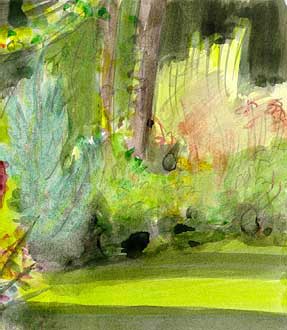
In my garden (detail) 8/19/03
I've been, uncharacteristically, alone here. Yesterday noon J. headed gone up north to visit family, and I stayed here because of a client meeting early this morning. Last night I sat out on the back porch and watched the light slowly fade on the garden. Something moved me to get out my watercolors, so I went inside and rummaged around, assembling a water jar, brushes, a piece of hot pressed paper, and my big palette of now-dried paints. It felt good to sketch and paint; after half an hour I had a noble failure, but this is typical for watercolors. I took my elephant-ear sponge, soaked it, squeezed it, and rubbed out the areas that were overworked. Ah, improvement. Then back with the paints, more contrast, a little detail in the foreground...
Painting is absorbing, frustrating, exhilarating, joyful. I used to paint and exhibit quite a lot, in oils and in watercolors, and then, as I've focussed more and more on writing, I've nearly given it up. Lately, though, the urge has returned - it always comes when I'm in museums and see good work, feel the paint vicariously under my fingers. I was fortunate enough to have a gift for drawing from very early on. My mother is an artist, and my father could have been, and they encouraged me to make things and to be creative. I always had paints and clay, scissors and papers, chalks and crayons, and all the adults around me made things -- from wood, or cloth, or thread. I was very serious about it for a long time, but then, as life became more complex, I realized I had to focus, and writing became the medium that made the most sense, seemed to have the most potential impact. And I was, I think, lonely. Words had always been my primary medium; writing was a way to connect. Even in the solitary act of writing, I could sense a reader and hear a response.
This summer, at the Montreal fine arts museum, I walked into a dimly-lit room containing Canadian art from the late 19th and 20th centuries, and suddenly felt hit in the gut. It was a visceral, overwhelming longing not just to look, but to pick up the brushes. And I can't do it, not seriously, not now, but I figure I can draw a little, begin to explore that part of myself again.
This morning the painting from yesterday looked as terrible as I had expected, but that's all right. Watercolor is the most unforgiving medium, and you have to throw out a lot of work for each one you keep. I'm very much out of practice. One good aspect of getting older is that you learn to appreciate the process more than the result; you know why you're doing something, and the doing becomes as important as the product, or, even more important, someone's eventual reaction. As I was painting yesterday, I saw the blue of the junipers, the chartreuse busy-ness of the heathers, the spotted light on the thicket of jewelweed across the lawn. And they stay with me today, sparkling in the late, fading light, because I looked at them last night with fresh, expectant, hungry eyes.
8:17 PM
|
Tuesday, August 19, 2003
POLISH POETRY V, continued
Tadeusz Rozewicz has a great many poems about poetry. His work is characteristically spare, so to some extent you have to search for the "I"; self-portraiture doesn't come as easily, or with as many adjectives, as it does to Milosz. Here, however, Rozewicz talks about the plainness of his language and makes it clear he knows exactly what he is doing, and why:
MY POETRY
explains nothing
clarifies nothing
makes no sacrifices
is not all-embracing
does not redeem any hopes
does not create any new rules of the game
takes no part in play
has a defined place
which it has to fulfil
if it's not a cryptic language
if it speaks without originality
if it holds no surprises
evidently this is how things ought to be
obedient to its own necessity
its range and limitations
it loses even against itself
it does not usurp the space of another poetic
nor can it be replaced by any other
open to all
devoid of mystery
it has many tasks
to which it will never do justice
(1965)
And fourteen years later he wrote this remarkable description about the act of poetry, and the poet's vulnerability:
WHEN WRITING
when writing the poet
is a man whose back
is turned to the world
to disorders
of reality
he's surfaced
he's left
the animal world
traces of his
bird-feet
are stamped on drifting sands
from afar he still hears
voices words
women's grainy
laughter
but he musn't
look
back
when writing the poet
is defenceless
he can be easily startled
ridiculed
fettered
and confused
(1979)
9:37 PM
|

Guinea Pig
FURRY THINGS
Hairy chests and bare legs: Why (and when) did humans lose their body hair? This NYTimes article scratches beneath the surface...
Gerbils run amok in China: British animal humor is bizarre, but I think this article on an explosion of 16-inch Great Gerbils (Rhombomys opimus) in Xinjiang Province is for real. Animal lovers be warned, the scenario is not pretty. From the BBC.
4:35 PM
|
Monday, August 18, 2003
POLISH POETRY V
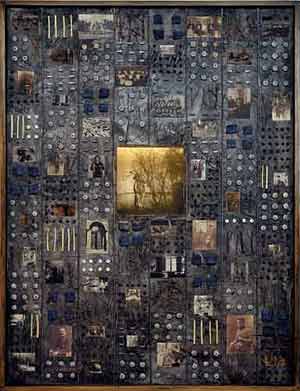
“Plate of Memory II” from an exhibition of assemblages and montages by Aleksandra Manczak at GalerieFF, Lodz. (The site uses frames; navigate to "list of exhibitions" and click on Manczak)
Both Milosz and Rozewicz have written many poems about poetry, and about being poets. Like Anna Akhmatova, they muse about this strange gift of the muse, and why it chose them. Unlike Akhmatova, who was prone to a certain amount of over-dramatization about her own role as poet/seer (which doesn’t diminish her work in my eyes at all), both Milosz and Rosewicz are disarmingly self-deprecating, considering what truly great poets they are.
Here is a short poem from Milosz, written in 1985 when he was living in Berkeley. One thing I’m looking for in reading these works is the effect of Catholicism, even in people who - because of what they’ve seen and experienced in life – struggle or reject the faith of their childhood. In just a few lines Milosz reflects on his attachment to sensuous pleasures and things of the flesh, and then obliquely excludes himself from “greatness”, while at the same time defining "literature".
My Lord, I loved strawberry jam
And the dark sweetness of a woman’s body.
Also well-chilled vodka, herring in olive oil,
Scents, of cinnamon, of cloves.
So what kind of prophet am I? Why should the spirit
Have visited such a man? Many others
Were justly called, and trustworthy.
Who would have trusted me? For they saw
How I empty glasses, throw myself on food,
And glance greedily at the waitress’s neck.
Flawed and aware of it. Desiring greatness,
Able to recognize greatness wherever it is,
And yet not quite, only in part, clairvoyant,
I know what was left for smaller men like me:
A feast of brief hopes, a rally of the proud.
A tournament of hunchbacks, literature.
Czeslaw Milosz
Translated by Czeslaw Milosz and Robert Haas
(from Spoiling Cannibal’s Fun, Northwestern University Press, 1991)
5:19 PM
|
Sunday, August 17, 2003
Le monde est grand, mais en nous
il est profond comme la mer.
(The world is large, but in us
it is deep as the sea.)
R. M. Rilke quoted in Gaston Bachelard's The Poetics of Space
I think what I was trying to get at yesterday is this: Is a person actually a place? Perhaps even an ultimate sort of place? And if so, what is a weblog in relation to that person?
Recommended: Maria's comment on this subject at Alembic.
5:15 PM
|
Saturday, August 16, 2003
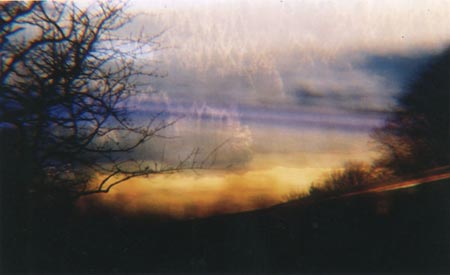
Nirvana series by Jacqueline Heer, via Conscientious
ECOTONE TOPIC for AUGUST 15: WEBLOG AS PLACE
We’ve talked a lot in these pages about the places we move in and out of: the big natural places; the created cities; the homes of our childhoods, made by others; the found places and secret hideaways; the less-easily-defined realms of the spirit. None of these places belong to us; they are bigger than we are and we move through them, marvelling at the ones that seem permanent – the night sky, the desert, the mountains – and mourning the loss of those that change or disappear. Walking past a snowberry bush today in another town, I instinctively reached out and squeezed a waxy white fruit, instantly remembering my childhood hiding place beneath my grandmother’s big snowberry bush. I wonder if it’s still there.
The blogosphere feels to me like an even bigger place than the aggregation of physical places we call “earth”; it is dimensionless, nearly unlimited both in extent and imaginative possibility, and while we may be able to trace its beginning no one can predict its future. Unlike natural physical places, it’s a virtual representation of the minds of human beings, extending with them backwards in time as well as representing, very nearly, the immediate present, and portending the likely trends of the future. That makes it, perhaps, the most human – and therefore most compelling, surprising, seductive - of all “places” ever created.
I’ve been making personal places all my life. Once, during a parent’s visiting day at school, my father gasped when he caught a glimpse of the inside of my desk. Yet what looked like chaos to him was precious and personal to me, and invested with meaning. The spaces I’ve made, from childhood corners through dorm rooms to my first apartments and eventually a rambling house and garden, have all retained some of that early “meaningful” chaos, through art, artifacts from the natural world, and the continual presence of books, paper, and words.
I wasn’t the one who discovered weblogs; J. did that and told me, long before I started one, “You ought to look at this. I think you’re a natural blogger.” When I did start The Cassandra Pages I really had no idea what I was trying to do, other than continuing the journal-style writing I’d always done, in a public way. The eventual importance of the visual content shouldn’t have surprised me as much as it did; both my weblog and physical home have a lot in common – except that TheCassandraPages are neater! Ideally, I guess I wanted my weblog to reflect me as accurately as possible, but also to be as hospitable to others as any physical place I could create. Trying to consciously do that – without voice, touch, warmth, eye contact - has been a fascinating challenge.
Blogging seems to prove a spiritual truth I’ve been writing and thinking about for a long time: people want and need to have a way of saying, “this is me, this is who I am” that goes much deeper than putting “Honk if you love golden retrievers” or “I love square dancing” signs on their bumpers. We crave self-expression both for its own sake, and because we crave communion. I think the virtual places we tend to return to are the ones that feed us, not unlike the physical places we visit, remember, and long to return to. We’re all looking for that elusive sense of home, where we’ll be welcomed just as we are.
Please read more responses to the current topic at the Ecotone Wiki
5:55 PM
|
Friday, August 15, 2003
Back home. First impressions: chaotic display of coleus, pansies, standard fushias and aloes on back porch desperately in need of water. Zucchini rampiante is definitely rampaging, having sent out 8-foot exploratory stems in my absence. Ditto for volunteer yellow pear tomato. Sunflowers two feet higher, lovely. House feels spacious, the landscape green, kitchen inviting. Vodka-and-tonic; quick Thai stir-fry with salad after garden foray for vegetables (tiny patty-pan squash, zucchini, carrots, tomatoes, fresh cucumbers); followed by pot of Arabic coffee with cardamom. Aaaahhh.
Montreal in forefront of memory: Hot. Sweaty back, tired feet, thrill of new visual impression every ten metres. People more undressed than here, less self-conscious. Visual variety. Creative jazz up my spine: images, pulses, colors, scents, vitesse …the beat of the present….only eventually turning into words. Thinking in French. Hot. Metro on rubber tires; flock of school children held together by a ribbon; old Chinese man reading newspaper; tired beggars asking for change. Woman riding bike in tight black dress and high heels; conservative Muslim couple in restaurant, even her mouth is covered. Rich lemony taste of fresh-grilled salmon. Walking the city at night, still hot. Financial district, Corinthian columns, the big river, gulls, mirror skyscrapers; concrete grain elevators. Catholicism and fur traders. Construction crew pounding I-beams into the earth, shaking me too.

As usual, I’ve come back more tired than when I left. We saw a couple of movies: Spellbound, a new documentary that follows eight kids bound for the National Spelling Bee – terrific – and The Matrix Reloaded at the huge Montreal IMAX theater. Quite the experience: I thought it was better than the reviewers did, but seeing and hearing it on that scale of course didn’t hurt.
Tomorrow we’re attending our first civil union. After that I hope to be able to contribute to the next Ecotone bi-weekly topic (due today, actually): "Weblog as Place".
8:48 PM
|
Thursday, August 14, 2003
We spent most of today investigating the Plateau Mont-Royal area of the city, and arranging for a week's apartment rental in November. I've been negotiating with the landlord in French by e-mail, and it seemed good to see the place and meet her, also because we're trying to see if this would be a suitable neighborhood for a longer rental period. As it turned out, we liked it very much. The shopping/restaurant area known as "Plateau Mont-Royal" is pretty trendy and hip, and also relatively expensive, but surrounding it are very nice residential areas that are reasonable, with tree-lined streets and ordinary, mixed neighborhoods of young and old. We wandered around the area, checked out the availability of laundromat, bank, metro, and stopped in at the local supermarche - which was filled with beautiful produce, fresh bread, and a long fish counter of far better and fresher fish than we get at home, and also less expensive. J. pulled me quickly past the local patisserie, but I convinced him to stop in for a creme glacee at a lovely little shop run by an older French woman and offering about twenty kinds of freshly-made ice cream and Italian ices (I had strawberry, he had a lait frappe with ginger ice cream).
We took our lunches to the large neighborhood park, filled with mature trees, benches, big grassy areas and recreational sections of all kinds: playgrounds, pool, softball, tennis. People of all ages were walking and biking through the park, some with dogs, and everyone was very relaxed and friendly. While we were eating a man came and sat down on one of the benches and began practicing on his African drum. I noticed two things that startled me: first, he carefully put a thick cloth over the head of the drum before he started playing, to muffle the sound so he wouldn't disturb people unduly. Second, two little girls, unaccompanied by parents, came up and began talking to him and asking if they could play the drum. None of them acted as if this was unnatural or unusual - the man talked to the girls, showed them what he was doing, the girls were totally relaxed, and everyone seemed to be having a good time. Other adults in the park paid no particular attention. I felt like this told me a lot about the general temperature of relations between strangers here, and the level of anxiety about random encounters. For example, girls alone on the street look at you and often say hi. People regularly make eye contact on the metro or on the street. I never feel scared here at any time of the day, and when you watch interactions between people, they always seem more relaxed than I'm used to in cities.
My impression over the past three years of visits has been of a society that is less polarized by wealth or the lack of it, and in which the priorities of life are different and perhaps more generally shared. I sense less competitive agressiveness, less consumerism, and less disparity in wealth. There may also be less mobility and opportunity - I don't know. There's a lot more to learn. Aesthetically, though, there is a lot that is pleasing, and much of it is the French sensibility: the blue enamel house numbers, wrought-iron filigreed railings and window grilles, lace curtains on every door and window, potted geraniums. And the food! And the food.
4:44 PM
|
Wednesday, August 13, 2003
Bonjour from Montreal. We made a quick trip up here to do some errands and take a couple of days off. To our surprise, after weeks of rain at home, it’s clear up here and very lovely. After blogging at “Zoni” (that’s what we call this internet/copy place – our name comes from the internet place J. used in Damascus) we’re going to walk up to Parc de Mont-Royal and watch the sun go down over the city. Then maybe a dinner of Asian noodles and a movie. We’re both pretty beat after some very hectic days with our regular work.
Driving up, the sky was filled with huge cumulus clouds, grey and white over slate-blue mountains. Fields of hay and corn lay between the foothills, and along the roadsides, goldenrod and chicory were at theheight of their bloom. Every few miles one of us said, "look over there!" or "look at that!" We finally concluded that we live in a postcard.
But once you enter Canada, the land gets flatter and flatter. Beyond the border lie vast fields of corn -both feed corn for cows and "mais sucre", advertised colorfully on handpainted signs in front of each farm. Under one farmstand canopy, we saw just the eyes and forehead of a girl behind a huge mound of sweet corn, large enough to feed our entire village back home. Two other sights characterize the change in countries: roadside bars with big signs advertising "danseuses nues", and the tall, shiny, aluminum-painted spires of the Catholic churches in each village.
More tomorrow...and maybe some pictures.
4:49 PM
|
Tuesday, August 12, 2003

Zahra Bahrami in Majid Majidi’s Baran – 2001
DON'T-MISS MOVIES
We've see a lot of movies, but two lately were so good I want to recommend them.
The first is Baran, the latest feature by Iran's Majid Majidi, the director of Children of Heaven and The Color of Paradise. I loved both of those, but felt that Baran was on an even higher level, a masterpiece. Not only are the performances (many by untrained actors) uniformly outstanding and believable, the cinematography masterful and often breathtaking (as those of us who are Iranian film buffs have come to expect), the story poignant and human -- it also presents a window into the plight of Afghan refugees trying to scrape by in Iran. (Most of the refugees pictured in this film came to Iran during the Soviet invasion). It's a film about racism and compassion, about male-female relationships within Islam, and about transformation. It's also, like Majidi's other films, about seeing and finding beauty amid dire poverty and desperation.
The second terrific movie is Y Tu Mama Tambien, a Mexican production directed by
Alfonso Cuar?n, that knocked us off our feet. It's the story of two boys uncomfortable on the cusp of manhood - are they ever - and a slightly older woman with whom they go on a road trip. The film's advertising quotes the Washington Post as saying this is "the best road trip movie ever". Well, maybe, it's right up there. Beautifully made on a low budget, excellent screenplay, great direction, many surprises, and fine performances by everyone, especially the Spanish actress Maribel Verdu.
Both movies are available for rent from NetFlicks.com
By the way, I'm sorry and annoyed that HaloScan's comments have been down lately - please keep trying.
5:05 PM
|
Monday, August 11, 2003
FEVER-TREES
Following up on those trees on the banks of the great, grey-green, greasy Limpopo: fever-trees are cichona, the tree that gave quinine its name. An article in today's New York Times, "The Miraculous Fever-Tree", gives the details (Joel, this is for you!):
Ms. Rocco, who is the literary editor of The Economist, makes the pursuit of quinine (an ingredient in tonic water) her book's primary focus. She cites early discoveries of the title tree, which would be named cinchona (with a bark that yields quinine) in Peru, where early Jesuit missionaries understood its importance. She also discusses how valuable this substance would have been in Rome, which at one time was "the most malarious city on earth..."
7:29 PM
|
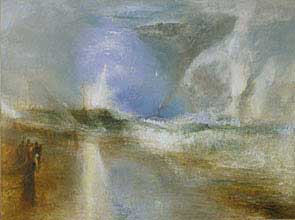
Rockets and Blue Lights by J.M.W. Turner, 1840
Yesterday was a feast for my eyes, ears, and spirit. Generous, dear friends had invited me to travel with them to Massachussetts to visit an exhibition of the late seascapes of J.M.W. Turner at the Clark Institute in Williamstown, Mass. , have a picnic lunch, and then go to Tanglewood for an afternoon concert .
I’d seen many of the Turners before, at the Tate, but while in London (despite my liking Turner very much) I felt overwhelemed by the sheer number of canvases and the yellow-ness of the paintings against the Tate’s light-colored walls, here the exhibition was focussed, manageable, and hung against a calming and complementary deep marine blue. I like the most abstract paintings the best, but I was struck by two of his very last seascapes that depicted whaling – one with a giant harpooned sperm whale about to overturn one of the chase boats, and the other a much more ethereal, even allegorical painting of a whaling boat putting in to an arctic port, with the severed head of a sperm whale hanging from the rigging, barely visible through fog. Yet for all the intensity and energy of Turner’s oils, I sometimes think my favorites are his small watercolors, painted on location – maybe because in them I can sense his spirit and even look over his shoulder as he moves his brush.
After the visual banquet, we ate our picnic of rosemary bread, fresh tomatoes and basil, Boston lettuce, cold chicken breasts, and cherries under a canopy while teeming rain fell through the tall tamaracks and oaks that flank the Clark’s pink marble exterior.
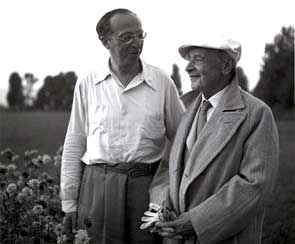
Aaron Copeland and Serge Koussevitsky at Tanglewood
Then – on to Tanglewood, the summer home of the Boston Symphony, in the beautiful open hills of the Berkshires. The centerpiece of the afternoon was Renee Fleming, resplendently glowing in a copper satin dress with fitted waist, vast skirt, and plunging neckline, singing Richard Strauss’s Four Last Songs – the final songs he ever wrote, set to poems by Herman Hesse. I know these songs well; I’ve loved them for a long time, listened to my old LP of Elisabeth Schwartzkopf until it skips, and even sung through them myself back when I was studying voice.
Just as Fleming began, one of the strongest thunderstorms I can remember let loose and sheets of water literally cascaded off the roof of the Serge Koussevitsky Shed, Tanglewood’s big venue, which is open on three sides. Somehow, though, the storm was fitting, and it kept the 2000-person audience riveted to the stage. Fleming’s concentration never faltered, and her voice was limpid, searching, tender and strong: the perfect vehicle for Strauss’s final commentary. I wasn’t the only one wiping tears from my cheeks at the end.
Upon Going to Sleep (Song #3)
Now the day has made me weary
let the starry night gather up
my ardent longings, lovingly,
as it would a tired child.
Hands, leave off all your toil,
mind, put aside all your thoughts:
all ym senses long
to settle, now, into slumber.
And the soul, unencumbered,
wants to soar in free flight
into the night’s magic realm,
to live deeply, a thousandfold.
Hermann Hesse
You can listen to Renee Fleming singing excerpts from her all-Strauss CD here.
4:35 PM
|
Saturday, August 09, 2003
THE ELEPHANT'S CHILD
Awake in the middle of the night, I got up and worked on some knitting, and then decided to have a cup of chamomile tea and read a little. My hand fell on a dark green book with a fragile binding that J. had been reading a few nights ago, under similar circumstances. It was Kipling's Just So Stories, a copy given to my mother in 1928 by one of her aunts. This was, I'm sure, the copy that was read to me when I was young as well.
J. had asked me about the book because, like me, he hadn't heard the stories since he was a child, and was highly amused to encounter them again. I looked through the contents, and chose the one that had been my favorite: The Elephant's Child. Soon I was accompanying our hero along the banks of the great grey-green, greasy, Limpopo River to his showdown with the Crocodile. Forty-plus years hadn't erased the basic story, but I didn't remember the tall aunt (it was my tall aunt who loved to read this story to me), and the broad aunt, and I certainly didn't remember the stellar and singular character of the Bi-Coloured-Python-Rock-Snake (who always talks like that).
J. came stumbling out of the bedroom about then, and I offered to make him a cup of tea and read him the story. Since I'd already had a once-through, I was prepared with an array of animal voices and even stuffed-and-stretched noses. We laughed together, cheered the Elephant's Child, admired Mr. Kipling, and went back to sleep.
7:44 PM
|
Friday, August 08, 2003
POLISH POETRY IV: ROSEWICZ IN ITALY
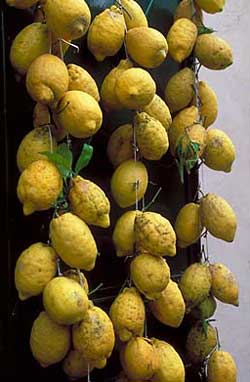
Amalfi Lemons by Jay J. Pulli
Tadeaus Rosewicz continually revisits the haunting questions posed by his early experiences, but he also wrote some poems that contain luminous, beautiful images and that are, for him, almost extravagant in their language. There’s always a certain lurking darkness, and the enormously effective portrayal of a stranger’s aloneness in a foreign city, but there are also moments when the poet, perhaps in spite of himself, gets caught up in what he’s seeing.
“Et in Arcadia Ego” is a long poem, in three parts, written in the early 1960s, about a trip Rosewicz took to Italy. It surprised me, both by its length (in my copy it runs to some 22 pages) and in the way the poet’s normal reticence and spareness imbue his descriptions with heightened sensuality, vividness, and metaphorical power that simply don’t come across in more florid verse. As the poem proceeds, he describes wandering the streets of Naples, a trip to the Sistine Chapel, and a military parade.
Obviously I can’t quote all of it, but here is a favorite section. The poet is in Naples.
from Et in Arcadia Ego by Tadeaus Rosewicz
streets converged
and diverged in the twinkling of an eye
he stood paralyzed asking for a name
was shown many streets
was shown the way
people smiled hurried on
hurried on were polite
two girls
with two tongues licked
heaps of ice-cream with warm
tangues they licked white and pink
ices
bunches of lemons hung
with rigid lacquered leaves
bananas lay curved
patched with black
brown figs
pink melons moons
of water and light in a hippo skin
with rows of pips in the mouth
next to that lay a second head
head on top of head and head next to head
a pyramid of heads rose
up to the whitened sky
blind heads of coconuts
covered with tawny hair
crushed with saliva in a white interior
the dented rim of a stone vessel
of an extinct volcano
a dark mountain over a transparent bay
stirred and came to him
came to his feet
the bay threw an arc
he was motionless
4:05 PM
|
Thursday, August 07, 2003
ANGLICAN, BUDDHIST, OTHER...
To all who have been following the recent discussions on religion here and elsewhere, I'd like to commend the current post at The Coffee Sutras. Kurt has an explanation of his Episcopaliansim that could have been mine: the rich liturgy, the music, the openness, the social conscience, with the absence of the most objectionable Catholic doctrines.
I have to add, however, that when you are in a church led by a conservative priest, it can be very hard to find that openness. Our former priest, who was of that ilk, recently left, but not until the parish had been wracked with division and underhanded dealing of the most un-Christian kind. We are still reeling.
I'm astounded by the arrogance of human judgmentalism, and the way this judgement, and need to feel "right" and "inside" has given rise to so many other -isms, responsible in turn for so much suffering. Scripture has been used, and abused, for any purpose under heaven. Christians bent on clinging to exclusionary ideas so conveniently forget that the New Testament was transmitted as a reformation of the Old, and that the "new commandment", simple and ultimately challenging -- "love one another as I have loved you" -- superceded all the old laws. I think we can be pretty sure that this was the central message of Jesus' ministry. It appears in several different forms in all the Gospels, and his life was a testament to that belief in action, to the shock of all who observed and accompanied him. When he added, "on this commandment hang all the Law and the Prophets" he was making the priorities clear: when faced with the humanity of another -- your neighbor, whoever he or she may be: Gentile or Jew, rich or poor, man or woman, sinner or saint -- choose love rather than the kinds of judgement that formerly excluded that person.
"Love your neighbor as you would love yourself." Whenever I'm unsure how to act or react in my own life, I try to ask this question: "Does this action (or thought) lead me toward greater love, or away from it?" If I can't answer, then I do nothing until the path is clarified. But usually I can. We can usually determine if the action we're contemplating is a loving one, or an unloving one, and the more we examine our thoughts, the faster and more easily we can know ourselves and where we're headed. I figure if I do this as much as possible, I can't go too far wrong - and if I do, forgiveness will be there. That's the "love yourself" part - another great spiritual difficulty!
The concept of unconditional love may be Christian, but I learned how to know myself from Buddhism.
Tomorrow - back to the Polish poets!
4:46 PM
|
Wednesday, August 06, 2003
Thanks to all of you who have been commenting on yesterday's post. My mother told me a young Catholic friend recently asked her, "Who are the Episcopalians, anyway? And what makes them different from Catholics or Methodists, for example?" He also asked her to explain about bishops, and she told him that bishops had the difficult task of being spiritual leaders and also being the administrative heads of large organizations - the dioceses (groupings of churches by region or state) they're in charge of. (Bishops also representing the Church-at-large -- although Episcopal bishops have great freedom to express themselves, far more than Catholics who have to answer to the Vatican.)
These are all significant questions that I'm willing to go into in more detail if people are interested, but today I wanted to speak about the inherent tension that exists between the Church as an institution, and the religion itself as set out in the teachings of Jesus as we know them, along with the example of the earliest Christians. Sometimes that tension is so extreme that the two are actually opposed to one another. For those of us "within" the church, this is not always as apparent as it is to people "outside", who like the boy watching the naked Emperor, see through the hypocrisy and excuses quite easily.
The problem is one of self-preservation: institutions, the more organized and wealthy and hierarchical they become, begin to exist in order to perpetuate themselves, rather than the noble idea that began them. The original idea often needs no structure at all: it exists in the hearts, lives, and acts of ordinary, simple people motiviated as individuals and often, though not always, encouraged through community. The early Christians forbade priestly robes and trappings; they pooled their possessions, served the poor, the widowed, the sick, and the orphaned; and worshipped in "house churches" that moved from one dwelling to another, often to avoid persecution. The "Church" as we know it began only after secular rulers finally accepted Christianity, and the religion became intertwined with state power and invested with all the trappings of royal office. Once you head down that slippery slope, memory fades quickly.
I served for three years on the board ('vestry") of my own local parish, and during that time we undertook a capital campaign to renovate and enlarge our buildings. I was opposed, feeling that in today's world, there are many uses for that kind of money that are more appropriate and certainly more "spiritual" justifiable." Although a number of people in the parish agreed with me, the "powers" in the church adamantly wanted the building and justified it on the grounds that it would "help our mission". Poppycock. Well, I lost, they won, and there's going to be a big fancy new facility. That's how the Vatican got built, too, while peasants all over the world starved.
I'm disappointed with Rowan Williams, the new Archbishop of Canterbury. He's known as a liberal on gay issues, and has written sensitively on the subject. But he's now the head of a worldwide communion of Anglicans, and when faced with the difficult choice of courageous spiritual leadership, or the need to preserve the institution, he seems to be choosing the latter. The pressure must be enormous. There is the very real possibility of a split, with conservative African and Asian congregations walking out. Also, homosexuality is such a closet-issue in England, still, and the British seem fraught with fears that American liberalism could force open some of those closet doors at home. British Anglicans are still hotly contesting the issue of women priests, although a few have been ordained, while female priests and bishops are becoming a non-issue in the United States.
Without strong and courageous spiritual leadership, I think a split is even more likely. Sadly, fundamentalist interpretations are only strengthened when the institution appears frightened and weak. Likewise, those on the outside who might be encouraged by a strong message of inclusivity and love tend instead to see the weaknesses and the hypocrisy. I'm grateful that the Episcopal Church in the United States is organized as an autonomous body and that we're free to vote and act as we see fit; the courage right now is coming from this side of the ocean, but we may soon find ourselves on more of an island than we thought.
9:39 PM
|
Tuesday, August 05, 2003
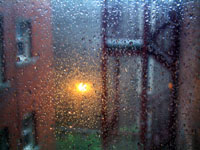
"Weather": one of 26 Things by jmcolberg at conscientious
26 THINGS
I'm liking the concept and the various entries I've seen in 26 THINGS: 26 specified subjects that people interpret photographically and post on their own blogs. Here are a few from people I visit:
from qB
from conscientious
from natalie d'arbeloff at blaugustine
BEYOND BELIEF
When I started blogging in April of this year, I was coming off two years of writing about almost nothing but politics and religion; TheCassandraPages has been an attempt to find some peace and sanity for myself as well as kind of coming at what I view as a basic problem - cultural fear and indifference - from a different angle.
(!*#@*!DAMN! There's a bat in the house. Back in a bit...10 minutes: a record capture-and-release. We have a new fishing net technique that seems to work well, with little trauma to either bat or humans. These are regular visitors in the summer, and we let them fly around, with the lights on, until they decide to hang upside down from a track light or some such place, and go to sleep. Then the fishing net goes over the bat, a little nudge to get it to fall down into the net, and out the door. This one allowed itself to be captured without even the usual "eek-eek-eek" or trembling, and I got to watch its amazing flight as it seemed to "map" the room.)
All right. So I've resisted writing about the writhings of my (Anglican) church about electing and approving an openly gay bishop - until today, when I feel like I have to say something. As it happens, I know Gene Robinson a bit. I've worked with him on committees and have nothing but admiration for the man. The last-minute allegations of sexual wrong-doing by Rev. Robinson struck me as preposterous, but certainly had to be taken seriously - which they were. Word just came through that he has been approved - but it's clear to everyone that the opposition won't stop here. This editorial in the Minneapolis Star-Tribune lays it out pretty well.
There's been a good discussion over at In a Dark Time about Elaine Pagel's book on Gnosticism, "Beyond Belief", and it touched on some of the issues that these current political struggles within Christianity point out - particularly the way so many people feel excluded (by the legacy of centuries of patriarchy, by racism, by sexual orientation or marital status, by poverty or wealth, and especially by scepticism and doubt) from a religion that is supposed to be inclusive and love-centered. I am saddened by this, but I think I understand it well, having spent at least twenty years of my life as an agnostic, out of the church, or considering spirituality outside organized religion and through the study of Buddhism. Now that I am "back in" the church of my birth, so to speak, I'm proud of the Episcopal Church and especially the Diocese of New Hampshire for electing Gene Robinson and for standing up for what I think Jesus Christ's message really was - to love one another and leave judgement to God. I'm proud that we ordained women priests. I'm proud of the church's stance on peace and justice issues, and particularly proud that there is room in my tradition for doubt, discussion, and change. But I also find myself alienated from the Church at large, and from the political wrangling that has consumed it from the very beginning. Organized religion unfortunately tends not to be very much about God, but about men (and women) and power. Jesus said it himself.
So the conservatives and liberals will continue to duke it out. These days many of us find it hard to even admit we're Christian, when the word has taken on so many unpalatable connotations: Franklin Graham's evangelical mission "armies" poised on the borders of Iraq, for one; the hypocrisy and sad retrenchment of the Catholic Church for another. Meanwhile, I prefer to think of the individuals who quietly take the teachings of Christianity and other religions seriously- and keep right on praying for the world, trying to alleviate suffering, and growing in compassion.
7:52 PM
|
Monday, August 04, 2003
TREES, IN PICTURES
My husband Jonathan, known here as "J", has been a professional photographer for, well, longer than either of us would like to admit. He recently put together a portfolio of tree pictures and I've put them on a photoblog; please take a look. As he will tell you, he's not the verbal member of the family, but there are other equally valid methods of communicating. I'm hoping he'll post here a little more often and share his work with you.
7:02 PM
|
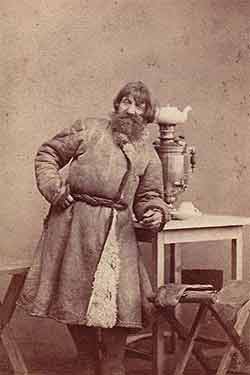
Peasant with Samovar, from the exhibition St Petersburg: A 300th Birthday Tribute
People and Palaces in Photographs around 1900
Somerset House, London, 14th June - 10th August 2003
In her comment on my Trees post from August 1, Elena (who is to be congratulated on her new blog – don’t miss the Modigliani/Loretta Lux comparison!) quoted Anna Akhmatova’s poem “Willow”, and I think it bears repeating here:
I was raised in checkered silence
in the cool nursery of the young century.
Human voices did not touch me.
It was the wind whose voice I heard.
I favoured burdocks and nettles,
but dearest to me was the silver willow,
my long companion through the years,
whose weeping branches
fanned my insomnia with dreams
Oddly, I have survived it::
out there a stump remains. Now other willows
with alien voices intone
under our skies.
And I am silent ... as though a brother had died.
(1940)
Translated by Stanley Kunitz with Max Hayward
Although I love Akhmatova, I’m not sure I had read this poem before writing that essay, but I did remember one of my favorite Tolstoy short works, Hadji Murad, in which the recollection of the story is prompted by Tolstoy seeing a mangled but still heroically-living thistle in a field. In spite of Akhmatova’s supposed disdain for Tolstoy, I now wonder if she remembered that work as well.
While we're on the subject of famous St. Petersburg-ites, there may be those who, like me, were underwhelmed or even annoyed by Ian Frazier’s sniveling New Yorker article about St. Petersburg’s 300th anniversary. This brief and much less self-absorbed comment may be closer to reality as well as literature. It’s from the BBC’s current series on “cities that inspired literature”, and is written by Ingrid Bengis, the daughter of Russian emigres, who grew up in the US but moved to St Petersburg in 1991. She’s the author of Metro Stop Dostoevsky.
It's terrible and it's beautiful. It's exciting and it's boring. It's trashy and it's elegant. And it's everything. Everything that has affected me at least - all the literature connected with St Petersburg - has a somewhat hallucinatory quality.
The sense of something glorious but something not stable on its feet. I think the fact that the city is built on a swamp really has an effect on that. The sense that the whole city could disappear in a second.
There is also that sense of discordant elements constantly clashing against each other, of this society that is kind of whirling around at tremendous speed.
So I think a major theme of this city, if you're going to choose only one, would have to do with destiny, a sense of destiny. And what is that destiny - trying to define that destiny, and running from that destiny, trying to escape from it and then being caught by it again.
5:09 PM
|
Sunday, August 03, 2003
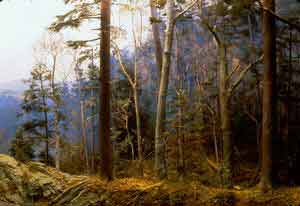
Pre-Settlement New England Forest - 1700 AD
In a comment on the last post, Miguel points out the comforting fact that, while the New England forests were clearcut in the 1800s, these forests are now coming back. He's right. In all but the most populated areas, you rarely see a clearcut hillside. It is true, though, that where development has occurred there is no going back - at least not in the forseeable future. Of course, in the very long run, that may well be different. What we're experiencing now is an intensification and concentration of development in particular areas, and an abandonment of formerly-tilled and habitated land in the more remote regions, as people move closer to population centers for employment.
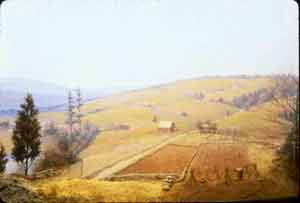
Height of Forest Clearing and Agriculture, 1830 A.D.
I don't have photographs of the hill in back of our house before it was cleared for farming, because that was before photography. We do have pictures showing it at before the turn of the 20th century, and there is barely a tree in sight. The scrubby second- or third-growth woods at the top and down the hill to the north are being cut now for more housing, but further up, and farther away from the commercial and population centers - within walking distance from my house - there is real second-growth forest with large trees: white pine, maple, cherry -- much like what you see in the first picture above. Walking in a woods like that never fails to renew me.
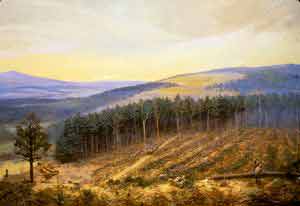
"Old-Field" White Pine Forest on Abandoned Farmland, 1910 A.D.
In colonial times, nearly all the straight, virgin white pines up and down the Connecticut were cut and floated down the river to become masts for His Majesty's ships. There are still a few virgin white pines left, and they are magnificent - Eastern cousins in spirit and inscrutibility to the conifers of the Northwest coast. The picture above is still pretty typical on th edges of farmland, but the totally-white pine second-growth forest has given way to a mixed forest dominated by hardwoods.
The pictures here are from some famous dioramas depicting the stages of the northestern forest at Fisher Museum Harvard Forest, where you can see the whole series and read this chapter of American history.
4:36 PM
|
Friday, August 01, 2003
TREES: Ecotone Topic for August 1
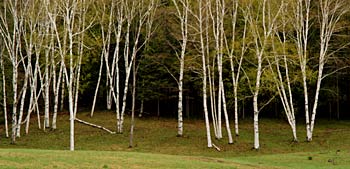
Birches. Photograph by J.
I live in a forest. Anyone who doubts that should fly over northern New England: you can’t see the people for the trees. When visitors arrive from un-woody places, like England, or our new neighbors from virtually tree-less Iceland, they are overwhelmed by the omnipresence of trees, and the way the forest dominates not only landscape but life. We heat with wood, build with wood, boil tree sap into syrup; smell wood being cooked into paper and sawn into boards, wait for lumber trucks and trees being skidded out of the forests, watch rivers of yellow tree pollen flow in the streets after rain, see trees breathing their oxygen back into the clouds. Our world here is green, and blue, and more green: Ver-mont was aptly named.
In a city we find ourselves one among many, and so the woman in the red dress, or the man who sings out from his newstand as you pass it each day becomes a focus. Here there are too many trees to comprehend, and so it’s the white pine standing taller than all the rest that captures your attention; or the grove of thorny locusts above the riverbank, knarled and conversant like old souls. I could write in a dozen directions about trees, but for today’s topic I’m just going to offer an essay I wrote several years ago about a tree that shared my place on earth for many years.
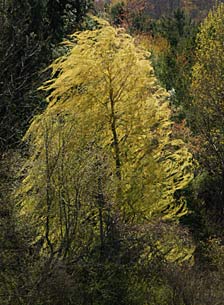
While with an eye made quiet by the power
Of harmony, and the deep power of joy,
We see into the life of things.
Wordsworth, “Lines Written Above Tintern Abbey”
The big willow is being cut. I’m upset about it, know it has to be done, but it’s such a great and beautiful tree, worthy of being mourned. I’ve looked up into its branches for twenty years now, especially on summer evenings, when the only light was from the moon, to see stars shining through the leaves so far above my head, and fireflies dancing among them. It always felt like its own world, up there, in the bowls formed by those great dark branches, populated by things of the air and heights. A pair of orioles nested in the tree each spring, serenading me as I turned over the first soil in the garden; later their purse-like nest swayed above me. And it was home to many smaller birds: chickadees, nuthatches, warblers, feeding no doubt on a vast colony of insects. Kneeling next to the garden beds I’d feel drips of water raining down on me all summer, even during dry weather, and wonder whether willows really wept, if that was how they got their name.
Branches fell continually, especially in spring storms, and I used the long supple tender ones to make woven fences and supports for herbs and other plants. It was a high-maintenance tree for us, and we didn’t even own it, but I never minded. I drew it many times, painted a watercolor, wrote a poem --trying unsuccessfully to capture that mysterious, secret world suspended in the sky.
When this hill was a pasture, a stream flowed between our property and the neighbors’, and along its banks a line of willows grew up. Ours was the first house cut out of the farm proper, near the turn of the century. Over the last twenty years, the hillside, divided and subdivided, became house lots. The willows -- streambank trees, never intended for shade -- were left in one back yard or another, sending their shallow roots into basement walls and dropping branches each spring. Homeowners, sympathetic at first, grew tired of taking care of the trees and worried when major damage occurred in thunderstorms. It’s understandable. But as is always the case, it doesn’t matter that the trees were here first, that we are, in fact, the ones who have encroached on them.
Last night, after dinner, the chain saws in the neighbors’ yard were finally silent. I went out on the back porch and looked over at the willow. The tree stood there still, its great wide crown shorn, one main trunk remaining with all its branches and leaves, the others amputated into huge logs that lay around the base. It was a horrible sight but heroic in a way; the tree, still alive, retaining something of its nobility and the strength emanating from that huge solid trunk, easily five feet in diameter at chest height. Yet it was doomed; this would be its final night, the last time those branches reached toward sunlight, leaves stretching a few new millimeters in length. I came back upstairs, drew a basin of water for the dishes, and started to cry, filled with sorrow for mankind, for being alive at a time and in a culture which values the safe, the cheap, the fast solution: whatever fits easily into our lives and causes the least inconvenience. I cried rueful tears for myself, made so sad by a tree -- how out of step I am, and how painful it is to stubbornly refuse the cries of a culture that would gladly give up Bach for the sitcom-of-the-moment; where artists, musicians and poets eek out a living and developers get rich.
I’ll remember the willow best on those nights, years ago, when I was trying to figure out if God existed. After I’d meditated for an hour, the incense burned down to ash, candle extinguished, I’d come out into the night, and to my polished mind, open, newly innocent, every sensation appeared fresh, important, astonishing. The Milky Way had never seemed so vast, the air so exhilarating, the snow under my feet so white. And there the willow loomed: hugely alive, pulsating with being-ness and a quality of home that strangely did not feel closed to me. I stopped trying to paint it or write about it, but just stood there, night after night, as if it were part of the meditation ritual; looking up, not thinking, I let it tell me whatever it had to say.
7:43 PM
|
|
|